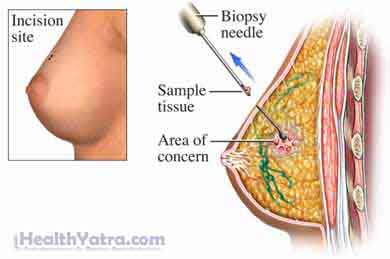Definition
Breast needle biopsy is the removal of a sample of breast tissue using a needle. The sample is examined in a lab. There are different types of breast needle biopsies:
- Fine needle aspiration
- Ultrasound-directed needle biopsy
- Stereotactic core needle biopsy
- Magnetic resonance imaging (MRI)-guided breast biopsy
- Vacuum-assisted device biopsy
Reasons for Procedure
Breast needle biopsy is done to examine a suspicious area in the breast. It may be done if any of the following are found:
- Lump
- Tissue thickening
- Nipple abnormality
- Discharge from the nipple
- Abnormal ultrasound or mammogram image
The biopsy can identify the area as either benign (noncancerous) or malignant (cancerous).
Possible Complications
Complications are rare, but no procedure is completely free of risk. If you are planning to have a biopsy, your doctor will review a list of possible complications, which may include:
- Bleeding
- Infection
- Bruising
Some factors that may increase the risk of complications include:
- Obesity
- Smoking
- Poor nutrition
- Chronic illness (eg, diabetes)
- Bleeding disorder
Be sure to discuss these risks with your doctor before the procedure.
What to Expect
Prior to Procedure
Your doctor may do the following:
- Physical exam, especially a breast exam
- Blood tests
- Mammogram and/or breast ultrasound
Leading up to the biopsy:
- Talk to your doctor about your current medication. Certain medication may need to be stopped before the procedure, such as:
- Anti-inflammatory drugs
- Blood-thinning drugs
- Shower the morning of the biopsy. You may be asked to use a special antibacterial soap.
Anesthesia
You may receive local anesthesia. If this is the case, the area that is being operated on will be numbed.
Description of the Procedure
The doctor will choose from several types of biopsies to get a tissue sample:
Fine Needle Aspiration
The skin over the area will be cleaned. A small needle will be inserted into the breast tissue. Fluid and/or tissue will be removed. The needle may be removed and re-inserted more than one time. After this is done, the doctor will apply pressure to the area and cover the spot with a bandage.

Ultrasound-directed Needle Biopsy
An ultrasound device is used to locate the area where the biopsy needs to be taken. An ultrasound uses sound waves to create an image of the breast tissue on a monitor. After the location is found, a small needle will be inserted in the breast tissue. Samples of fluid and/or tissue will be removed. A bandage will be applied after the needle is removed.
Stereotactic Core Needle Biopsy
The doctor may have you lie down on your stomach or sit depending on the equipment being used. Mammogram or ultrasound images will be taken to locate the suspicious area. The doctor will make a tiny cut in your breast and insert a special probe. Using the probe, the doctor will remove several core samples of breast tissue from the area. After this is done, the area will be covered with a bandage.
MRI-guided Breast Biopsy
In some instances, the suspicious area can only be seen using an MRI. Because of this, an MRI-guided breast biopsy may be needed. This procedure takes more time. Tell your doctor if you have a cardiac pacemaker. It may affect the procedure.
Vacuum-assisted Device Biopsy
The doctor will insert a needle and use pressure from a vacuum to pull tissue from the mass through the needle. The tissue is then placed into a sampling chamber. This method lets the doctor collect multiple tissue samples during one needle insertion.
How Long Will It Take?
It will take less than one hour. After the procedure, the tissue collected will be sent to a pathologist who will look at it under a microscope. It may take about 2-5 days to receive the test results.
Will It Hurt?
There will be slight pain in your breast after the biopsy. Your doctor may prescribe pain medication.
Post-procedure Care
At Home
When you return home after the procedure, do the following to help ensure a smooth recovery:
- Take pain medicine as directed by your doctor.
- To relieve discomfort, apply a warm compress or a heating pad to the area.
- Wear a supportive bra.
- Ask your doctor when you should change the bandages.
- Be sure to follow your doctor’s instructions.
Call Your Doctor
After arriving home, contact your doctor if any of the following occur:
- Signs of infection, including fever and chills
- Redness, swelling, increasing pain, a lot of bleeding, or discharge from the biopsy site
- Nausea and/or vomiting that you cannot control with the medication you were given after surgery, or that last for more than two days after the procedure
- Pain that you cannot control with the medication you have been given
- Cough, shortness of breath, or chest pain
- Pain and/or swelling in your feet, calves, or legs
In case of an emergency, call for medical help right away.
